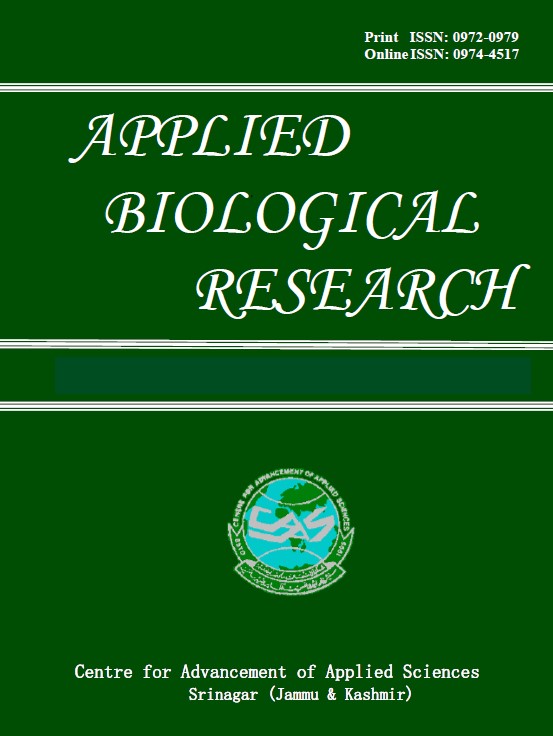OPTIMIZATION OF CoQ10 PRODUCTION BY A MUTANT OF Cereibacter sphaeroides GSPC DUBSRUSING RESPONSE SURFACE METHODOLOGY
DOI:
https://doi.org/10.48165/abr.2025.27.01.14Keywords:
Cereibacter sphaeroides, CoQ10 enzyme production, media optimization, RSMAbstract
While screening for a few novel bacterial strains capable of producing coenzyme Q10 (CoQ10), a wild-type Cereibacter sphaeroides strain was isolated and identified. To increase the production of CoQ10 by this wild-type strain, optimization of the upstream process was carried out through response surface methodology (RSM). To maximize CoQ10 synthesis, a central composite design (CCD) was used to optimize the media composition, which included sucrose, ammonium sulphate, peptone, and MgSO₄. The desirability function approach was used to determine the ideal level for each element, and CoQ10 concentrations were tracked as response variables.
The results indicated that using the optimal culture composition (30 g L⁻¹ sucrose, 15 g L⁻¹ ammonium sulphate, 25 g L⁻¹ peptone, and 0.50 g L⁻¹ MgSO₄) produced an average of 8.5 mg g⁻¹ dry cell weight (DCW) of CoQ10. Regression analysis results showed that the most efficient factors in generating CoQ10 were MgSO₄ and ammonium sulphate concentrations.
Downloads
References
Adachi, O., & Yakushi, T. (2016). Membrane-bound dehydrogenases of acetic acid bacteria. In K. Matsushita, H. Toyama, N. Tonouchi, & A. Okamoto-Kainuma (Eds.), Acetic Acid Bacteria: Ecology and Physiology (pp. 273–297). Springer, Tokyo, Japan.
Arkan Yousif, H., Al‐Ani, I., Hajleh, M. N. A., Matalqah, S., Dayyih, W. A., & Al‐Dujaili, E. A. (2025). Preparation and evaluation of complexed ubiquinone (coenzyme Q10) antiaging hyaluronic acid–vitamin C serum for skin care. Journal of Cosmetic Dermatology, 24(1), e16706. https://pmc.ncbi.nlm.nih.gov/articles/PMC11683515/
Asai, K., Fujisaki, S., Nishimura, Y., Nishino, T., Okada, K., Nakagawa, T., et al. (1994). The identification of Escherichia coli ispB (cel) gene encoding the octaprenyl diphosphate synthase. Biochemistry Biophysics Research Communication, 202, 340–345.
Balakumaran, P. A., & Meenakshisundaram, S. (2015). Modelling of process parameters for enhanced production of coenzyme Q10 from Rhodotorula glutinis. Preparative Biochemistry and Biotechnology, 45(4), 398–410.
Bule, M. V., & Singhal, R. S. (2009). Use of carrot juice and tomato juice as natural precursors for enhanced production of ubiquinone-10 by Pseudomonas diminuta NCIM 2865. Food Chemistry, 116(1), 302–305.
Cheng, W., & Li, W. (2014). Structural insights into ubiquinone biosynthesis in membranes. Science, 343, 878–881.
Cluis, C. P., Burja, A. M., & Martin, V. J. (2007). Current prospects for the production of coenzyme Q10 in microbes. Trends in Biotechnology, 25(11), 514–521.
Ernster, L., & Dallner, G. (1995). Biochemical, physiological and medical aspects of ubiquinone function. Biochemistry Biophysics Acta, 1271, 195–204.
Godini, E., Asgarani, E., Fooladi, J., & Ghashghaei, T. (2017). Optimization of catalase production by Kocuria sp. ASB107 using response surface methodology and molasses as the carbon source. Journal of Applied Biotechnology Reports, 4(1), 519–525.
Hu, Z. C., Liu, Z. Q., Xu, J. M., Zheng, Y. G., & Shen, Y. C. (2012). Improvement of 1,3-dihydroxyacetone production from Gluconobacter oxydans by ion beam implantation. Preparative Biochemistry and Biotechnology, 42(1), 15–28.
Kawamukai, M. (2002). Biosynthesis, bioproduction and novel roles of ubiquinone. Journal of Bioscience and Bioengineering, 94, 511–517.
Kien, N. B., Kong, I. S., Lee, M. G., & Kim, J. K. (2010). Coenzyme Q10 production in a 150-l reactor by a mutant strain of Rhodobacter sphaeroides. Journal of Industrial Microbiology and Biotechnology, 37(5), 521–529.
Lv, G. Y., Wang, P., He, J. Y., & Li, X. N. (2008). Medium optimization for enzymatic production of L-cysteine by Pseudomonas sp. Zjwp-14 using response surface methodology. Food Technology and Biotechnology, 46(4), 395–401.
Moghadami, F., Hosseini, R., Fooladi, J., & Kalantari, M. (2021). Optimization of coenzyme Q10 production by Gluconobacter japonicas FM10 using response surface methodology. Journal of Applied Biotechnology Reports, 8(2), 172–179.
Poljungreed, I., & Boonyarattanakalin, S. (2017). Dihydroxyacetone production by Gluconobacter frateurii in a minimum medium using fed-batch fermentation. Journal of Chemical Technology and Biotechnology, 92(10), 2635–2641.
Prout, K., Mandyam, K., & Nanjundaswamy, A. (2025). Optimization of β-carotene production and nutritional characterization of Rhodotorula glutinis ATCC 32766 under submerged fermentation. https://papers.ssrn.com/sol3/papers.cfm?abstract_id=5191599
Sood, B., Patel, P., & Keenaghan, M. (2025). Coenzyme Q10. In: StatPearls [Internet]. Treasure Island (FL): StatPearls Publishing. https://www.ncbi.nlm.nih.gov/books/NBK531491/
Suzuki, K., Ueda, M., Yuasa, M., Nakagawa, T., Kawamukai, M., & Matsuda, H. (1994). Evidence that Escherichia coli ubiA product is a functional homolog of yeast COQ2, and the regulation of ubiA gene expression. Biosciences Biotechnology and Biochemistry, 58, 1814–1819.
Takahashi, S., Nishino, T., & Koyama, T. (2003). Isolation and expression of Paracoccus denitrificans decaprenyl diphosphate synthase gene for production of ubiquinone-10 in Escherichia coli. Biochemical Engineering Journal, 16, 183–190.
Tian, Y., Yue, T., Yuan, Y., Soma, P. K., Williams, P. D., Machado, P. A., et al. (2010). Tobacco biomass hydrolysate enhances coenzyme Q10 production using photosynthetic Rhodospirillum rubrum. Bioresource Technology, 101(20), 7877–7881.
Tokdar, P., Wani, A., Kumar, P., Ranadive, P., & George, S. (2013). Process and strain development for reduction of broth viscosity with improved yield in coenzyme Q10 fermentation by Agrobacterium tumefaciens ATCC 4452. Fermentation Technology, 2, 1. https://www.walshmedicalmedia.com/open-access/process-and-strain-development-for-reduction-of-broth-viscosity-with-improved-yield-in-coenzyme-qsub10sub-fermentation-b-19932.html
Wei, G., Yang, X., Gan, T., Zhou, W., Lin, J., & Wei, D. (2009). High cell density fermentation of Gluconobacter oxydans DSM 2003 for glycolic acid production. Journal of Industrial Microbiology and Biotechnology, 36(8), 1029–1034.
Young, I. G., Leppik, R. A., Hamilton, J. A., & Gibson, F. (1972). Biochemical and genetic studies on ubiquinone biosynthesis in Escherichia coli K-12: 4-hydroxybenzoate octaprenyltransferase. Journal of Bacteriology, 110, 18–25.

